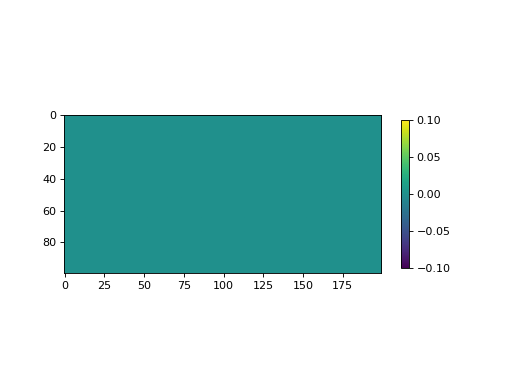Changing topographic diffusion to represent tree throw¶
Here, we demonstrate how to overwrite an existing method of the DeltaModel to achieve custom behavior during model runtime.
Note
This example demonstrates several best-practices, including using yaml parameters specifications, custom figure and grid saving setup, and using get_random_uniform for random number generation.
In implementing custom model subclasses, it is common to want to change runtime behavior of the model. This can often be achieved by using hooks alone, but sometimes a combination of hooks and overwriting existing methods is necessary.
In this example, we calculate a diffusion multiplier to represent tree throw. In this super simple and likely way over-exaggerated representation of this process, we assume:
there are trees everywhere the elevation of a cell has been above self.dry_depth for 10 consecutive timesteps
there is a probability threshold of tree throw occurring anywhere trees exist
tree throw makes the diffusion multiplier for that cell on that timestep really big!
Important
There are all kinds of problems with the assumptions in this example. Don’t read into it too much. It’s an example to show how to modify code, not how to represent tree throw.
class TreeThrowModel(pyDeltaRCM.DeltaModel):
"""Implementation of tree throw.
"""
def __init__(self, input_file=None, **kwargs):
# inherit from base model
super().__init__(input_file, **kwargs)
self.hook_after_create_domain()
def hook_import_files(self):
"""Define the custom YAML parameters."""
# whether to run vegetation
self.subclass_parameters['tree_throw'] = {
'type': 'bool', 'default': False
}
# tree throw multiplier
self.subclass_parameters['p_tt_mult'] = {
'type': ['int', 'float'], 'default': 100
}
# tree throw establish timesteps
self.subclass_parameters['p_tt_iter'] = {
'type': ['int', 'float'], 'default': 10
}
# tree throw prob threshold
self.subclass_parameters['p_tt_prob'] = {
'type': ['int', 'float'], 'default': 0.2
}
def hook_init_output_file(self):
"""Add non-standard grids, figures and metadata to be saved."""
# save a figure of the active layer each save_dt
self._save_fig_list['tree'] = ['tree']
# save the active layer grid each save_dt w/ a short name
self._save_var_list['tree'] = ['tree', 'boolean',
'i4', ('time',
'x', 'y')]
def hook_after_create_domain(self):
"""Add fields to the model for all tree parameterizations.
"""
self.tree = np.zeros(self.depth.shape, dtype=np.int64)
self.dry_count = np.zeros(self.depth.shape, dtype=np.int64)
self.tree_multiplier = np.ones_like(self.depth)
def hook_after_route_sediment(self):
"""Apply vegetation growth/death rules.
"""
# determine cells dry and increment counter
_where_dry = (self.depth < self.dry_depth)
self.dry_count[~_where_dry] = 0 # any wet gets reset
self.dry_count[_where_dry] += 1 # any dry gets incremented
# if tree_throw is on, run the tree placing routine
if self.tree_throw:
# trees die anywhere wet
self.tree[~_where_dry] = int(0)
# trees go anywhere dry for more than threshold
_where_above_thresh = (self.dry_count >= self.p_tt_iter)
self.tree[_where_above_thresh] = int(1)
# determine the multiplier field
_rand = np.array([get_random_uniform(1) for i in np.arange(self.depth.size)]).reshape(self.depth.shape)
_thrown = np.logical_and((_rand < self.p_tt_prob), self.tree)
# ignore the strip of land
_thrown[self.cell_type == -2] = 0
# set to ones everywhere, then overwrite with multiplier
self.tree_multiplier[:] = 1
self.tree_multiplier[_thrown] = self.p_tt_mult
def topo_diffusion(self):
"""Overwrite with new behavior.
This method is very similar to the base DeltaModel code, but we add an
additional multiplier to represent tree throw.
"""
for _ in range(self.N_crossdiff):
a = ndimage.convolve(self.eta, self.kernel1, mode='constant')
b = ndimage.convolve(self.qs, self.kernel2, mode='constant')
c = ndimage.convolve(self.qs * self.eta, self.kernel2,
mode='constant')
self.cf = (self.tree_multiplier * self.diffusion_multiplier *
(self.qs * a - self.eta * b + c))
self.cf[self.cell_type == -2] = 0
self.cf[0, :] = 0
self.eta += self.cf
And the model is then instantiated with:
mdl = TreeThrowModel(
tree_throw=True)
We don’t actually run this model at all in this example.
Let’s plot the .tree field just to see that the subclass was instantiated correctly.
fig, ax = plt.subplots()
im = ax.imshow(mdl.tree)
plt.colorbar(im, ax=ax, shrink=0.5)
plt.show()
